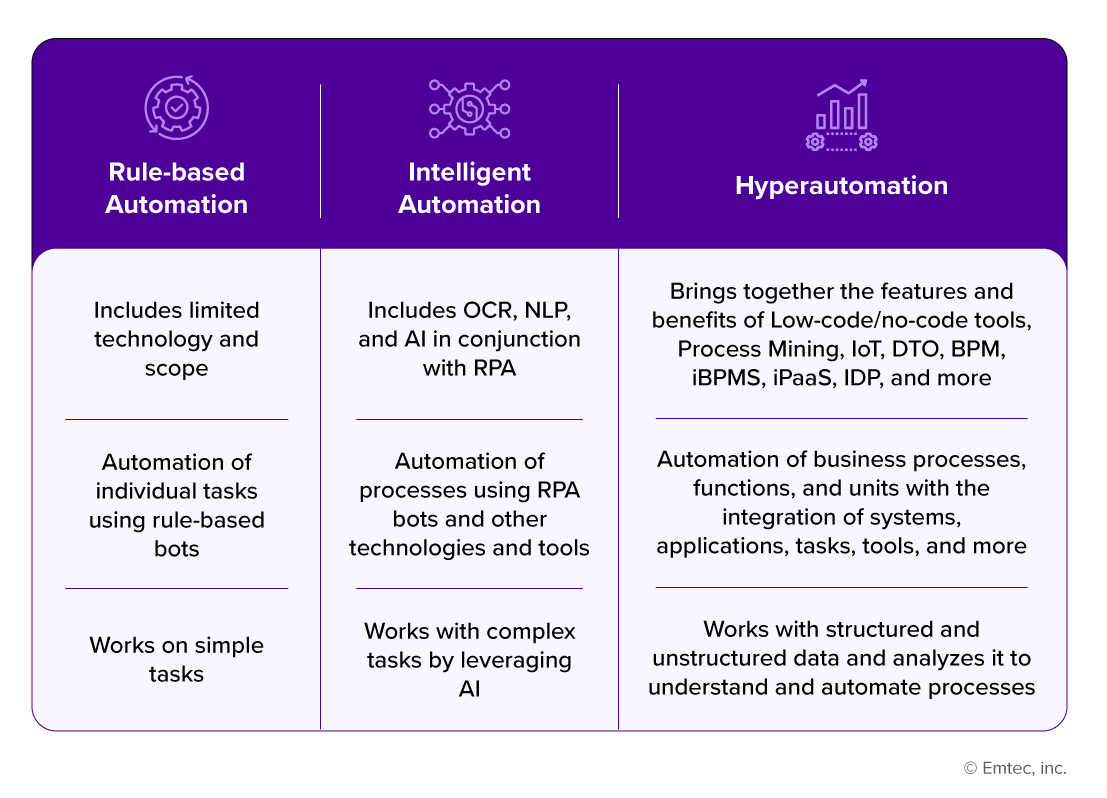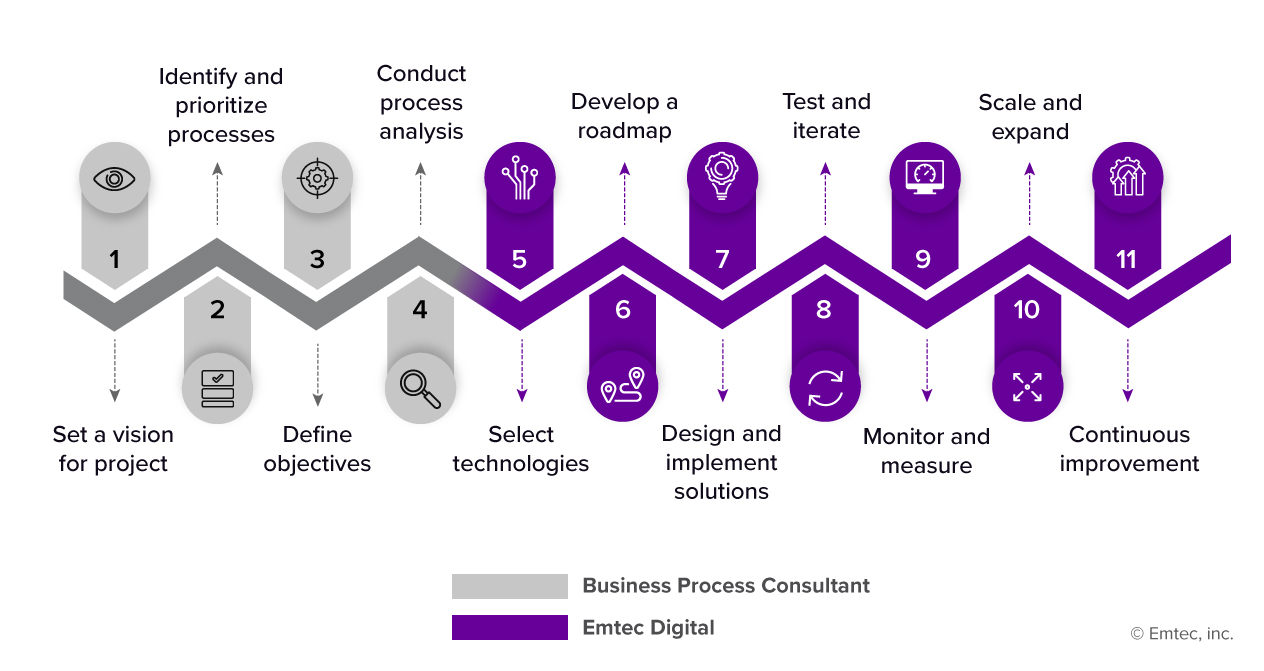It is time to extend your rule-based projects with an enterprise-wide automation strategy leveraging hyperautomation. This blog explores the benefits of hyperautomation and the steps involved in its implementation.
Today, software is omnipresent. Thanks to consistent updates, software is becoming more efficient every day. No wonder it is providing businesses with incremental changes. But is that enough? Ambitious businesses expect more from their technology. Time, cost and effort savings with enhanced efficiency and productivity, ambitious organizations demand these benefits and more. But with their current digital landscape, is there any ray of hope?
Hyperautomation is a business-driven, disciplined approach that organizations use to rapidly identify, vet, and automate as many business and IT processes as possible. – Gartner
Yes, the ray of hope is hyperautomation. Combining multiple automation technologies at once, hyperautomation is helping businesses save not a few hundred or thousand but whopping million-person hours! These time savings can be used to achieve anything that an organization wants, build its rocket to the moon or a submarine that reaches deep into the ocean!
Also, did you know that hyperautomation is set to help Heineken save a million person hours by 2025?
It is time to understand its details. The year was 2019. Gartner coined the term ‘Hyperautomation’ and has not looked back since. To understand hyperautomation, we can break it down into hyper, which refers to the scale of its features and benefits and automation which denotes the process of automating manual labor. Hyperautomation undertakes multiple automation initiatives and crosses the boundaries of restricted tool features and functionalities.
By extending the scale of automation technologies, hyperautomation enhances growth, innovation, efficiency, accuracy, and improves organizational performance. Let us understand why organizations prefer hyperautomation as a natural next step after rule-based and Intelligent Automation.
Hyperautomation Extends Benefits of Rule-based and Intelligent Automation
The size of organizational data is peaking more than ever. Businesses need an intelligent tool that capitalizes, analyzes, and derives insight from ever-increasing data. Hyperautomation has the power to win any size and structure of data, evolving customer needs, and business models.
The promise of hyperautomation is end-to-end automation of office work leveraging various technologies, including RPA, Artificial Intelligence (AI), and Machine Learning. – Automation Anywhere
By combining the forces of multiple technologies at once, it is here to hike the benefits of myriad automation tools and technologies.

Hyperautomation: Benefitting People, Processes, and Systems
Gartner reports that initiatives are now more likely to be driven by business units and fusion teams than IT departments. While cost saving is a key aspect of 90% of hyperautomation srtategies, faster cycle times and higher quality business processes are also key goals.
By combining the features of myriad automation technologies, hyperautomation also combines their benefits. Let us look at ways it empowers businesses.
- Simplify Operations for Maximum EfficiencyImagine a business unit where people, processes, applications, and systems are in sync, and talk to each other. Yes! This is not merely a concept but an actual benefit that hyperautomation offers. It enables seamless integration and interoperability across business units for increased team collaboration and simplified operations.
- Combine Human and Tech ForceManual busy work is neither fun nor productive for an employee. Daily, mundane, and repetitive tasks are thus better performed by automation bots. As digital workers, they ensure everyday tasks are completed faster and better. Also, by freeing up labor-intensive activities, employees can focus on tasks that demand human attention to experience the joy of work.
- Comply More to Standardize BetterAutomation bots are built with rules and conditions which fulfil requirements of various industry and process standards. Whether it is to safeguard and protect employees, rightly serve customers, or be true to market conditions, process automation bots can do it all. Thanks to hyperautomation, organizations can better adhere to protocol and conform to standards for improved compliance ratings.
- Improve Business Value and Reduce HassleThe combination of ML, AI, NLP, OCR, IDP, and ROC in automation bots ensures the highest efficiency, accuracy, and productivity in business processes. Minimal downtime, easy troubleshooting and rule-based operations help you reduce errors, time, and costs. Moreover, you will also experience reduced expenses in recruiting and training employees for everyday tasks. Leverage the current ones to accelerate bot functions instead and scale up operations as per your needs.
- Towards Assured FutureproofingBusinesses are always on the lookout for ways to accelerate go to market of products and services, get speedy feedback, improve, and expand their clientele. Hyperautomation allows people, processes, and technology to synchronize seamlessly. For ambitious businesses, this synchronization means effort, time, and cost-savings, optimized operations and meeting fluctuating market demands.
To sum up, hyperautomation enhances teamwork, eliminates boredom, and empowers the development of great products and services. However, these benefits result from the right strategy and execution. To do so, you need to identify and resolve a few challenges.
Prerequisites to Avoid Hyperautomation Failure
As a business leader, adopting new technologies is in your DNA. You ensure the funds, skills, and resources availability to onboard modern technology. However, the lack of technical awareness fails you and the project. Here are three prerequisites which can help you achieve your goals and avoid failure. They will also help identify challenges of hyperautomation and equip you with ways to combat them.
- Right skillsHyperautomation projects have the potential to transform organizations. However, it requires diverse skills with technical, business and people-specific expertise. Skilled personnel are also crucial to strategize and implement tools and their numerous components. Only proper engineering, management, and technology skills can set the right goals and discover the right processes to be automated.A skilled partner often saves the day by bringing skills and expertise at once.
- Right set of automation toolsThe current automation scenario is an ever- evolving marketplace of products and services. You need a special set of tools to meet your unique business needs. The right automation tool will extract the best features from RPA, ROC, Process Mining, Conversational Bots, and several other automation technologies and provide you desired benefits.
- Right cultureChange is the only constant. With changing technology tools, you can also expect constant adjustments in people’s mindsets and methods of working.
Furthermore, the key is to remember that a successful hyperautomation strategy is about using the collaborative intelligence of humans and technology. – Raghu Ravinutala, Yellow.ai
However, the right organization environment will always promote evolution and provide means to adapt to it. Gaining stakeholder and management support is crucial here. As leaders, they can ensure transparency in the following situations and successfully implement hyperautomation:
- Explaining the role and value of hyperautomation in daily operations
- Aligning team’s contributions and responsibilities towards business goals
- Establishing collaboration between people, processes, and technology
Towards Implementing Hyperautomation
Our client, the first neo bank in the US, saves $100,000 with automation. Read the whole story.
Let us understand the roles and resources, involved in implementing a hyperautomation project from scratch.

Looking at the above process of implementing hyperautomation, it is certain that it is in no way a one man’s job. It demands a wide variety of skills and resources.
The project initiates with identifying business objectives and only business leaders can do it. Later, business process consultants use these business goals as the project ‘vision’ and proceed to assess and identify business functions or processes that need hyperautomation. Each function or process is chosen to align with a specific business goal. Commonly desired goals include improving efficiency, reducing manual work, cutting costs, enhancing productivity etc.
Kickstart your Hyperautomation Journey with Bridgenext
We, as IT Partners enter after the business and automation goals are agreed upon. Our services range from identifying and implementing automation tools and technologies, troubleshooting, and maintenance and support. We empower our clients with the benefits of hyperautomation irrespective of their implementation stage.
We are a team of technocrats hungry and passionate about resolving business challenges with technology. As your automation implementation partners, we will help you build your custom digital solutions using our Intelligent Automation suite that includes Robotic Process Automation (RPA) Implementation, Conversational Bots, Process Mining, and Automation as a Service. We are ready to kickstart your hyperautomation journey, are you?
References
forum.uipath.com/t/what-is-hyperautomation-and-how-is-it-different-from-rpa/251230
www.uipath.com/resources/automation-case-studies/hyperautomation-fuels-growth-for-heineken
www.automationanywhere.com/company/blog/rpa-thought-leadership/the-benefits-of-hyperautomation-for-today-s-business
www.blueprism.com/resources/blog/hyperautomation-the-competitive-advantage/
www.analyticsinsight.net/hyperautomation-top-10-use-cases-of-end-to-end-automation-in-2020/
ts2.space/en/hyperautomation-for-automotive-and-transportation-industry/
www.tangoe.com/blog/implementing-hyperautomation-into-your-organization/
www.processmaker.com/blog/4-steps-to-hyperautomation-roadmap/#



